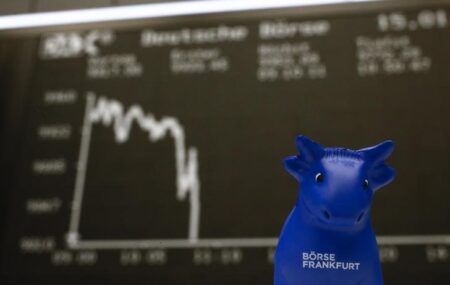Americold Realty Trust (NYSE: NYSE:), a leading global provider of temperature-controlled infrastructure, has reported a substantial increase in its second quarter 2024 financial results. The company’s Adjusted Funds From Operations (AFFO) reached approximately $109 million or $0.38 per share, marking a 36% rise from the same period last year.
This performance was primarily driven by robust same-store warehouse services and effective pricing strategies to combat inflation. Americold also reported a core EBITDA of $165 million, reflecting an industry-leading margin of 25%. The company has raised its full-year 2024 AFFO guidance to a range of $1.44 to $1.50 per share, indicating a significant increase from the previous year.
Key Takeaways
- Americold’s AFFO per share increased by 36% year-over-year to $0.38.
- Core EBITDA reached $165 million, with an EBITDA margin of 25%.
- The company successfully launched the first phase of Project Orion with minimal disruption.
- Full-year 2024 AFFO guidance raised to $1.44 to $1.50 per share.
- Americold is capitalizing on pricing initiatives and service margin improvements.
- Development projects are underway in Sydney and Allentown, with further expansions planned.
- Total net debt stands at $3.3 billion, with total liquidity at $554 million.
- Despite lower throughput volumes, Americold anticipates strong growth through pricing and services.
- The company’s service margins are expected to stabilize around 11%, with a goal of reaching 15%.
Company Outlook
- Americold expects economic occupancy to improve with potential consumer strength.
- Pricing for warehouse business remains solid, with annual GRIs driving increases.
- The company’s focus on customer service, labor management, and development projects is expected to sustain predictable growth.
Bearish Highlights
- Second quarter throughput decreased compared to the previous year.
- A cybersecurity incident in 2023 impacted earnings by $0.03.
- High product prices and a gap between promotional prices and consumer willingness to pay have led to lower throughput.
Bullish Highlights
- Strong same-store sales and increased NOI contribute to the positive outlook.
- Project Orion is advancing with little disruption, improving business processes.
- Americold remains the preferred choice for major food manufacturers and retailers.
Misses
- Non-same-store pool generated a negative NOI of $2 million in Q2.
- Certain purchase orders were delayed due to new systems, impacting earnings.
Q&A Highlights
- The company is optimistic about achieving a 15% service margin goal.
- Americold differentiates itself from competitors through customer service and value-added services.
- Customers are securing more fixed commitments in anticipation of demand recovery.
- Americold did not provide normalized throughput figures but is focusing on unit economics and service margin improvements.
Americold Realty Trust continues to navigate the challenges of the industry with a clear strategy focused on internal efficiencies, customer service, and growth initiatives. The company’s positive financial results and raised guidance reflect confidence in their ability to deliver value to shareholders and customers alike.
InvestingPro Insights
Americold Realty Trust (NYSE: COLD) has demonstrated resilience in its financial performance, with a notable increase in its second quarter 2024 financial results. As the company navigates through industry challenges and capitalizes on its strategic initiatives, several metrics from InvestingPro provide additional context to its current market position and future outlook:
- Market Cap (Adjusted): Americold’s market capitalization stands at $8.33 billion, underscoring its substantial presence in the temperature-controlled infrastructure industry.
- P/E Ratio: The company’s price-to-earnings ratio is currently negative at -25.38, indicating that it is not profitable as of the last twelve months ending Q1 2024. However, this is expected to change, as analysts predict Americold will be profitable this year.
- Dividend Yield: With a current dividend yield of 3.04%, Americold continues to provide a stream of income to its investors, which is an important consideration for those focused on dividend returns.
InvestingPro Tips highlight that Americold is a prominent player in the Industrial REITs industry, and despite recent profitability challenges, the company is expected to see net income growth this year. Additionally, Americold has experienced a strong return over the last three months, with a price total return of 27.76%, reflecting investor confidence in its recent performance and future prospects.
For investors and analysts seeking a deeper dive into Americold’s financials and market performance, InvestingPro offers a comprehensive array of tips. There are currently 6 additional InvestingPro Tips available for Americold at which provide valuable insights for a more informed investment decision-making process.
Full transcript – Americold Realty Trust (COLD) Q2 2024:
Operator: Greetings, and welcome to Americold Realty Trust Second Quarter 2024 Earnings Conference Call. At this time, all participants are in a listen-only mode. A brief question-and-answer session will follow the formal presentation. [Operator Instructions]. As a reminder, this conference is being recorded. It is now my pleasure to introduce your host, Mr. Kevin Reed, Vice President, Investor Relations. Thank you, Mr. Reed. You may begin.
Kevin Reed: Good afternoon. Thank you for joining us today for Americold Realty Trust second quarter 2024 earnings conference call. In addition to the press release distributed this morning, we have filed a supplemental package with additional detail on our results, which is available in the Investor Relations section on our website at www.ir.americold.com. This afternoon’s conference call is hosted by Americold’s Chief Executive Officer, George Chappelle; President of the Americas, Rob Chambers; and Chief Financial Officer, Jay Wells. Management will make some prepared comments, after which we will open up the call to your questions. On today’s call, management’s prepared remarks may contain forward-looking statements. Forward-looking statements address matters that are subject to risks and uncertainties that may cause actual results to differ from those discussed today. A number of factors could cause actual results to differ materially from those anticipated. Forward-looking statements are based on current expectations, assumptions and beliefs as well as information available to us at this time and speak only as of this date they are made and management undertakes no obligation to update publicly any of them in light of new information or future events. During this call, we will discuss certain non-GAAP financial measures, including, but not limited to, core EBITDA and AFFO. The full definitions of these non-GAAP financial measures and reconciliations to the comparable GAAP financial measures are contained in the supplemental information package available on the company’s website. Now, I will turn the call over to George.
George Chappelle: Thank you, Kevin, and thank you all for joining our second quarter 2024 earnings conference call. This afternoon, I am pleased to announce our financial results for the quarter and will also highlight key operational metrics. I will then discuss our updated outlook for the remainder of the year. Rob will provide an update on our recent customer initiatives and growth activity and Jay will discuss our capital position, liquidity, and provide a detailed walk-through of our updated full year 2024 guidance. I’ll begin with an overview of some key financial achievements for the quarter. We generated AFFO of approximately $109 million or $0.38 per share, an increase of over 36% from Q2 last year. We also generated core EBITDA of $165 million, an increase of 24.7% year-over-year, resulting in an industry-leading EBITDA margin of 25%. Our performance was driven in large part by continued strength of our same-store warehouse services, where we delivered a second consecutive quarter of double-digit margins coming in this quarter at 13.2%. To put this in an earnings growth context, increased warehouse services margins resulted in an incremental $40 million of NOI, or roughly $0.14 per share in the second quarter versus prior year, underscoring our ability to drive consistent, profitable, organic growth in a challenging macro environment. Last quarter, we highlighted our expectation that we could deliver services margins of 9% for the full year 2024, a year ahead of our original expectations, which would equate to approximately $100 million of incremental NOI on an annualized basis. Given the current productivity of our workforce, driven by over two years of hiring and retention progress, I am happy to report we are now on pace to exceed the $100 million target this year. Combined with new business wins, pricing initiatives, and continued systems and process improvements, global warehouse same-store NOI grew 19.3% year-over-year. Before I touch on our core priorities, I would like to provide an update on Project Orion. As a reminder, in February 2023, we announced our transformation program Project Orion designed to drive future growth and achieve our long-term strategic objectives through investment in our technology and business processes across our global platform. The primary goals of this project are to implement standard processes, reduce manual work, and incrementally improve our business analytics capabilities. Highlights of the project include implementing centralized customer billing, a human capital management platform, next-generation warehouse maintenance capabilities, and global procurement functionality to name a few. Even before the system went live, we saw numerous process improvements that led to increasing margins as we changed the way we worked to fit the system in Q1. We went live in North America and Asia-Pacific with the first phase of Project Orion in early May, and I’m pleased to report that we have had very little disruption internally or externally during and since the implementation. The rollout of Project Orion has been a contributing factor to our strong second quarter results. We expect it to continue to help drive growth and efficiency as we become more proficient in its use, expand its use across more geographies and functions, and unlock incremental functionality included in our new systems, such as embedded artificial intelligence. On a final note regarding technology, we experienced negligible disruption from the recent CrowdStrike (NASDAQ:) outages that happened across the globe a few weeks ago. Now let me review our top priorities and how they contributed to our results. Customer service is at the heart of what we do and a key driver of both occupancy and our continued progress in selling fixed commitment contracts. Our goal is to be the global cold storage provider of choice by delivering the highest quality customer experience through our people, our infrastructure, and our innovation. While economic occupancy showed a slight dip in this quarter to 78.1%, rent and storage revenue derived from fixed commitment storage contracts increased to 56.6%, 240 basis points higher than the previous quarter and 810 basis points higher than the second quarter 2023. The continued growth of these fixed commitment contracts is a result of delivering the best-in-class customer experience through our high quality infrastructure. Our customers’ willingness to engage in these contracts speaks to the quality of our assets and also acts as a leading indicator of positive things to come as customers sign them in the anticipation of volume growth in the future. With respect to labor management, it’s critical to our business that we have a safe, productive and well trained workforce to service our customers as efficiently as possible. Over the last two-and-a-half years, we’ve disclosed the key metrics in this area related to hiring, permanent labor content, retention, and workforce maturity to ensure the foundation we’ve built to support higher levels of productivity is very visible and should inspire confidence in the sustainability of our warehouse services margins. As we’ve said many times before, it’s the services part of our business that customers value the most, as it provides incremental supply chain benefit beyond simply storing a pallet and keeping it cold. The performance of our workforce not only ensures we service customers well within the dozens of individual services we currently offer, but also allows us to innovate and develop new services that further attract customers to our facilities. The continued refinement of our hiring and retention processes have resulted in a perm-to-temp hour’s ratio of 76:24, which is flat year-over-year and a slight decline sequentially due to the seasonality of agricultural harvest that drives a change in work content required from the first quarter to the second. Associate turnover finished the quarter at 38%, a 200 basis point improvement upon the first quarter. Our third key metric, our percentage of associates with less than 12 months of service, now stands at 23% has improved 600 basis points since the first quarter. As our workforce retention and maturity have improved, it should be no surprise our warehouse services margins have improved in tandem. Moving to pricing, in the second quarter, same-store rent and storage revenue per economic occupied pallet on a constant currency basis increased by 7.2% versus the prior year, and same-store service revenue per throughput pallet on a constant currency basis increased by 12%. Both were driven by pricing put in place in the back half of 2023 coupled with general rate increases or GRIs at the beginning of 2024. Pricing comps will compress in the second half of this year as we lap those increases. Our current outlook on pricing looks stable as we anticipate a relatively benign environment for inflation based rate actions. With regards to development, our priority is to only invest in highly accretive growth projects. The $200 million to $300 million guides for announced development starts in 2024, which is up from $100 million to $200 million last year, and tracking to potentially exceed the current range is committed to growth that will generate shareholder value across our three primary areas of focus. Our strategic partnerships with Canadian Pacific (NYSE:) Kansas City railway and DP World; expansion projects, which are most often occupied by existing customers; and customer dedicated built to suit developments. Our strategic partnerships are excellent examples of Americold’s unique ability to create value for our shareholders by partnering with global leaders who are experts in adjacent areas of the supply chain where we can leverage each other’s capabilities to identify opportunities to jointly grow our businesses. Through these collaborations, we have $500 million to $1 billion of potential development pipeline. Regarding expansions, I’m pleased to announce that last week we broke ground on roughly a $30 million expansion project in Sydney, Australia. Also in the quarter, we broke ground on an $85 million expansion project in Allentown, Pennsylvania. As a reminder, both expansions were announced in previous quarters as well as the groundbreakings of our inaugural Greenfield projects with our strategic partnerships, a $127 million development in Kansas City with CPKC and our $35 million development with DP World in Dubai. Our plan development starts at tracking towards the high end of our guidance for the year, and further underwriting is progressing well. Whether it’s a development or an expansion, we focus on design excellence, specific customer needs and actual work content that will take place within the walls of the facility. We are the only cold storage company with both automated and conventional facilities along all three nodes of the supply chain, a testament to our design skills, operational capabilities and knowledge of the overall end-to-end supply chain from farm to fork. Given the customer demand for our unique industry skills, I feel very confident our inorganic growth plans will continue to drive profitable growth for the foreseeable future. Lastly, I want to briefly address our updated full year guidance. Given the progress we have made driving organic growth through productivity and efficiency improvements, pricing and in combination with the investments we have made in our technological infrastructure, we are raising our full year 2024 AFFO per share guidance to a new range of $1.44 to $1.50 with a mid-point of $1.47, an increase of $0.05 per share from previous guidance and represents an approximately 16% increase from 2023. At the mid-point of the new range, our same-store NOI growth guide has increased to 12.5%. Before I turn the call over to Rob, I would be remiss not to touch on the new cold storage landscape with the recent entrance of another publicly traded cold storage company. We think this is an extremely positive event for the industry, bringing more investment dollars to the sector and helping show cold storage is an attractive asset class within industrial real estate. As it relates to Americold, having a true public peer in the space helps make us more competitive and ultimately more efficient and productive for our customers and investors. With that, I will turn it over to Rob.
Rob Chambers: Thank you, George. As George mentioned, I will provide an update on our recent customer initiatives and growth strategy. Starting with pricing initiatives. Our pricing initiatives continue to be a strength at Americold as we work tirelessly to ensure we price our business to reflect the value of the service we provide to our customers. We also have and will continue to price our services to offset inflationary pressures as they arise. In the second quarter, same-store rent and storage revenue per economic occupied pallet on a constant currency basis increased by 7.2% versus the prior year. Same-store constant currency services revenue per throughput pallet increased by 12% as a result of rate actions, better revenue capture, and incremental value-added services. We have made great progress in this area. Within our Global Warehouse segment, we had no material changes to the composition of our top 25 customers who account for approximately 51% of our Global Warehouse revenue on a pro forma basis. Our churn rate continues to remain low at approximately 3% of total warehouse revenues, consistent with historical churn rate. As George mentioned, we continue to be successful with increasing our fixed commitments with customers, and in the second quarter, rent and storage revenue derived from fixed commitment storage contracts came in at 56.6%, an increase of approximately $20 million on an annual basis and a 13th straight quarterly record for Americold. As our customer base composition, low churn rate, and progress on fixed commitments demonstrate, Americold continues to be the first choice for the world’s largest food manufacturers and grocery retailers when it comes to their temperature-controlled supply chain needs. Our customers want world class service and to partner with a provider who can support them at every node in the supply chain, from production advantage locations to major market distribution centers and then ultimately to retail distribution centers. This is a major competitive advantage and uniquely positions Americold within our industry to be the cold storage provider of choice. Turning to growth initiatives. Last quarter, we updated you on the groundbreakings of the inaugural projects with both of our strategic partnerships, the $127 million facility with CPKC and the $35 million facility with DP World. As George mentioned, we are pleased to announce the groundbreaking on both the roughly $30 million expansion project in Sydney, Australia, and the $85 million expansion project in Allentown, Pennsylvania. As a reminder, the Sydney project is a new dedicated conventional expansion project anchored by one of Australia’s largest grocers and will add mission-critical infrastructure in a capacity constrained market currently operating at greater than 90% occupancy. It is anticipated to add approximately 13,400 incremental pallets to our current capacity of roughly 18,700 pallets in that market. The Allentown project is a new conventional multi-customer expansion that will be approximately 37,000 pallet positions and approximately 15 million cubic feet. Those projects are on track from a timing and underwriting perspective, and we look forward to updating this progress in future quarters. In addition to these new projects, we continue to make progress ramping the five automated developments that we completed last year. Three of these automated facilities are supporting food manufacturing in Atlanta, Georgia, Russellville, Arkansas and Spearwood, Australia, and our proven solutions are performing well and delivering in line with expectations. These automated facilities house several of our largest customers at both their key manufacturing and distribution locations. The service levels being delivered by our best-in-class automation exceed industry standards and are a testament to Americold’s technical design and implementation capabilities. Given the success of our automation facilities in this sector, we expect to announce future automated expansions in the coming quarters. We continue to be thoughtful as we proceed with our two customer dedicated automated retail distribution centers in Lancaster, Pennsylvania and Plainville, Connecticut. Given the level of complexity and the importance of the customer relationship, we are being deliberate in our approach. At Americold, we’re interacting with major global customers both current and prospective every day, and a consistent theme in our discussions is the gradual recovery of consumer demand, and we’re positioning ourselves to take market share by providing best-in-class solutions. The development projects we mentioned earlier highlight the significant market opportunity that exists, and we are focused on converting that opportunity into outsized growth for Americold. What we’re hearing from our customers is the need to partner with someone who understands how to build efficiency and resiliency into their operations to support their future growth. Americold’s growth strategy is anchored in being able to create these solutions and we have developed this capability to a level that is industry-leading. Our supply chain solutions organization is the only group of supply chain scientists in the industry to develop automation at every node of the supply chain and are laser-focused on the science and the analytics behind the design needs that matter most to our customers including first, how to best optimize their supply chain. Customers who engage our supply chain solutions group are consistently presented with solutions that drive savings and improve performance as compared to their current network. Our team is utilizing industrial IoT and machine learning applications to drive speed to market with these solutions. Second, how to build and operate the most efficient facilities in the industry. Americold’s facilities maximize the cubic footage of the buildings by being 13% more dense than our closest competitor, driving efficiency for our customers and return on invested capital for Americold. The Americold operating system ensures best practices are utilized across our entire network. Third, when to deploy automation versus utilizing conventional solutions. Our supply chain solutions group analyzes the discrete work content associated with the customer or market, which we are building to determine if and when automation is appropriate versus adding conventional capacity. The result is a tailored solution that meets the needs of our customer or market without unnecessary added cost. Fourth, what the most important value-added services are that Americold can provide, by having a portfolio that includes facilities at every node in the supply chain, we are able to offer dozens of value-added services that drive our same-store warehouse revenue per economically occupied pallet 16% higher than our closest competitor. Fifth, how to create environmentally friendly cold chain solutions, as an example, driving energy efficiency into our buildings. Americold has over 200 buildings in our network that have been recognized by the Global Cold Chain Alliance’s Energy Excellence Program. That is more than 14x the number of buildings recognized in the rest of the industry combined. Another example includes our CPKC solution that will convert over 15,000 truckload shipments a year into rail shipments, a much greener mode of transportation. Our customers view Americold as an extension of their own supply chain organization, as evidenced by the long-term committed and global nature of our relationships. That type of trust is not built overnight. It’s built over decades of industry leadership. Now, I’ll turn it over to Jay.
Jay Wells: Thank you, Rob. Today, I will discuss our capital position and liquidity and update our full year guidance. Starting with our balance sheet. At quarter end, total net debt outstanding was $3.3 billion. We had total liquidity of $554 million, consisting of cash on hand and revolver availability, and our net debt to pro forma core EBITDA was approximately 5.3x. As we discussed last quarter, our expansion in Allentown, our Greenfield developments in Kansas City and Dubai, and our new expansion projects in Sydney, increase investment spend in the second quarter and will continue for the remainder of this year. Please see Page 38 of the IR supplement for additional details on our development projects. Turning to our updated full year 2024 guidance. As George mentioned, we are increasing our AFFO per share to the range of $1.44 to $1.50, an approximate 4% increase at the mid-point and an approximate 16% increase from 2023’s AFFO. Before reviewing the individual components of this guidance that are set forth on Page 41 of the IR supplement, let me quickly remind everyone of the 2024 same-store pool for the Global Warehouse segment. This pool has 226 facilities, which is approximately 96% of the total number of properties in our Warehouse segment. A summary of the 2024 same-store pool historic performance for the second quarter of 2023 is presented on Page 33 of the IR supplement. We have nine facilities that are in our 2024 non-same-store pool. Now, turning to the individual components of our updated AFFO guidance and starting with our Global Warehouse segment. We expect full year 2024 same-store constant currency revenue growth to be in the range of 2% to 4%. Let me provide more detail around the key drivers of this updated guide. With respect to occupancy and throughput volumes, as we discussed over the past quarter, our previous occupancy guide planned for a good summer grilling season, with manufacturers and retailers increasing promotional activities to drive consumer demand. The most recent reports from food manufacturers and producers show the consumer continues to be strained by stubborn inflationary pressures resulting in continued volume challenges. While not new news, it does warrant attention as throughput volumes continue to be muted. Based on the current economic outlook and recent commentary by food producers, we are reducing our expectations for economic occupancy to decline in the range of 200 basis points to 300 basis points compared to 2023, and throughput volume to decrease in the range of 2% to 4%. With respect to pricing, we expect constant currency rent and storage revenue per economic occupied pallet growth to be in the range of 4% to 5% and constant currency services revenue per throughput pallet growth to be in the range of 7% to 8%. As a reminder, the pricing guidance reflects our continued pricing and power surcharge initiative to cover known inflation. It also reflects our annual contractual escalation and GRI step-ups and the commercialization of market-based pricing for contracts that we underwrite or renew. Lastly, with regards to pricing, comps are expected to compress in the second half of this year as we anticipate a relatively benign environment associated with inflation-based rate actions. For the full year, we are increasing our same-store constant currency NOI growth to now be in the range of 11% to 14%. This increase is being driven by higher services margins. Based on productivity and pricing supported by new systems and processes, we now believe we can deliver services margins of over 11% for the full year 2024. Please note that service margins were higher in Q2, partly due to the implementation of Phase 1 of Project Orion and a new procurement system, which delayed certain Q2 operating expenses into Q3. If you just out these delayed expenses same-store NOI is forecast to grow sequentially from the first half to the second half of 2024. With regard to the 2024 non-same-store pool as can be seen on Page 33 of the IR supplement, the non-same-store pool generated negative $2 million of NOI in the second quarter 2024. For the full year 2024, we expect the non-same-store pool to generate NOI in the range of negative $7 million to positive $1 million. We expect the Managed and Transportation segments NOI to be in the range of $42 million to $47 million. We still expect core SG&A to be in the range of $219 million to $229 million. Turning to interest expense. For the full year, we are lowering our interest expense range to approximately $133 million to $141 million, a reduction of $2 million at the mid-point due to an increase in capitalized interest. There is no change to our full year cash taxes or maintenance capital expenditures guide. Regarding developments, as George mentioned, we are tracking to be at the high end or to potentially exceed the current guidance range of $200 million to $300 million of announced development starts in 2024. Please keep in mind that our guidance does not include the impact of acquisitions, dispositions or capital markets activity beyond that which has been previously announced and please refer to our IR supplement for detail on the additional assumptions embedded in this guidance. Now, let me turn the call back to George for some closing remarks.
George Chappelle: Thanks, Jay. As the operational and financial results of the second quarter highlight, it’s been another great quarter for growth at Americold. The effort put in by our team over the past two-and-a-half years to build a stable, productive workforce, enhanced with our recent technology implementation has created a solid foundation for sustained, predictable growth. While our company has never operated better, we have stepped up our investment in inorganic growth by investing almost double the amount of money in announced development starts as last year and now look to exceed those expectations due to the high demand for our design and construction services coupled with our world class operating model. We continue to grow our business through one of the most challenging consumer times in recent history. Over time, the consumer will strengthen and buying habits will normalize. And when that happens, we are positioned well to grow at a highly accretive and accelerated rate. As always, I want to give thanks to the over 15,000 associates around the world for their hard work and dedication every day. It’s their best-in-class customer service efforts that provide the foundation for our future. For this, I say thank you. We could not do this without you. Thank you again for joining us today, and we will now open the call for your questions. Operator?
Operator: Thank you. We will now be conducting a question-and-answer session. [Operator Instructions]. The first question comes from the line of Mike Mueller, J.P. Morgan. Please go ahead.
Mike Mueller: Yes, hi. As it relates to, I guess, the lighter throughput volumes, are there any categories specifically that are driving this? And then do you expect end the year in positive territory based on the forecast at the end of 2024?
George Chappelle: Hi Mike, I would say that, no, we don’t expect to end up in positive territory on throughput for the year. We’ll be down year-over-year based on our updated guide. And it’s not one category that’s driving the throughput down. I would say it’s an overall weak consumer in an environment where pricing in the grocery store is depressing volume. That’s been the case now for well over a year and I think has reached a tipping point very recently. But it’s the same story. Its high prices in the grocery store. It’s a consumer with less disposable income. And as I said, it’s been that trend for the last 12 months.
Jay Wells: Yes. Good morning, Mike. It’s Jay. Just to hit a little bit more on that, I mean, you look year-over-year throughput is going to be bad if you look at approximately about 1% if you do the back half of our guide. But if you look at sequentially with seasonality, our throughput is going to improve in the back half of the year if you look sequentially.
Mike Mueller: Got it. Okay. So by year-end, if we’re looking at 4Q, you’re expecting to be in the positive territory it sounds like.
George Chappelle: Sequentially. Sequentially, not year-over-year. I think that I was answering year-over-year. Jay is going through sequentially. He’s 100% correct. There’ll be a slight seasonal lift in the back half of the year sequentially from today let’s say, but year-over-year, we will be down in both the third and the fourth quarter.
Operator: Thank you. Next question comes from the line of Samir Khanal with Evercore ISI. Please go ahead.
Samir Khanal: Hey, good morning, everybody. And George, I guess, my question is around economic occupancy. How should we think about that? I know you kind of gave guide — you updated guidance for this year, but I’m talking even more beyond this year, given that when you look at economic occupancy and the physical occupancy, I mean, there’s a spread of about 900 basis points right now. And my only question is, given the macro out there and the challenges of slowdown you spoke about, I mean, could customers sort of deviate from this sort of safety stock idea and say, look, why are we paying for space that we’re not using at this point? So maybe you could provide a bit more color on that into next year?
George Chappelle: Yes. I would say that although the gap between physical and economic is 900 basis points, it has narrowed since the first half of the year by a couple hundred basis points. We expect it to narrow further through the second half of this year. When does it come back? It comes back when a consumer has disposable income. That comes closer to the pricing in the grocery store just as we said. Manufacturers do reduce safety stock when demand is down and demand is down, which is why I believe our economic occupancy is down. When it comes back as the consumer strengthens, and I think there’s hope for that in the second half of the year with potential interest rate cuts and other activity putting more money in a consumer’s pocket. I think the potential for that is certainly in next year, but maybe even the second half of this year. There seems to be a lot more aggressive talk around interest rate cuts that will help us consumer disposable income, that will close the gap to current pricing at the grocery store, that will raise demands, that will raise a safety stock, and the whole system grows again. So it’s all linked to the consumer, Samir, and right now, the consumer has never been weaker.
Jay Wells: And then maybe just one other point that I would add, Samir is, look, we’ve been in this environment now where it’s been a tough consumer for a number of quarters in a row, and yet every quarter you see our fixed commitments in terms of absolute dollars and percentages go up. We’re on our 13th straight quarter. We’re over 56% now another $20 million this quarter. So I think, like what you should take from that is that both Americold and our customers continue to benefit from the stability that that provides it.
George Chappelle: Also, I think as we said in the script shows that they believe that the second half has the potential in it, as I do, but it does require some consumer help, and it’s good to see that now many, many people are talking about the consumer, not only in our industry, but in other industries. And it seems as though consensus around interest rate cuts is building pretty quickly. So if help is on the way, we’re very confident that that will help our business. It’ll help occupancy, it’ll certainly help throughput and those tailwinds that I think could be as soon as the second half of this year should carry into next.
Samir Khanal: Got it. And then just as a follow-up here on pricing for the warehouse business, it still seems to be pretty solid year. I know we talked about inflation moderating, but it feels like you’re still getting good pricing power above inflation here. Does that guide value provided at four to five and then seven to eight for the services side? Does that sort of — can you sustain those levels into next year or…
George Chappelle: Yes. What we said on — in the prepared remarks is we expect those comps to narrow in the second half of this year. The pricing that you see in the results this quarter all happened in the second half of last year and also in the GRIs we took at the beginning of this year. So those costs will narrow. And based on the outlook for inflation we see today, we see the pricing environment is very benign. So I would say the bulk of our pricing going forward, if nothing changes will be our annual GRIs with some exceptions along the way that always exists, whether its new services or profile adjustments, et cetera. I call that normal course business. But when it comes to pricing actions, specific pricing actions, we don’t see any necessary where inflation is today. And you probably will see those pricing comps compress in the second half as well as next year. They’ll probably be more normalized, not back to pre-COVID, but I would say more normalized.
Jay Wells: If you triangulate our full year guide, it shows that back half of the year, we get to more normal type of increases, up 3% to 4%. So that that’s really what’s built into our back half guides.
Operator: Thank you. Next question comes from the line of Josh Dennerlein with Bank of America. Please go ahead.
Josh Dennerlein: Yes. Hey guys, thanks for the time. George, just wanted to kind of circle up on the service margins, second quarter in a row where they’ve come in double-digits. Just how are you thinking about where they ultimately, like, stabilize from here?
George Chappelle: Well, we did just over 13% in the quarter, and then as remember, Jay mentioned, some expense that was deferred to the third quarter. So if you rationalize that we get to just over 11%, and that’s where we adjusted the guide. So if I use 11% of the base, our retention metrics are excellent, better than pre-COVID. The system tailwinds we have are just beginning the system we just turned on May 6. So we do think there are tailwinds there. So is there some upside to the 11%? We believe there is, as the system gets better used and better understood, but at this point, throughput is still a headwind. So if I net those two together, we’re very comfortable with the 11% and all I can say is that’s where we are right now.
Jay Wells: Yes. I mentioned as part of implementing Project Orion and our new procurement system, certain POs were delayed as part of the process, so we could not buy certain types of material for our services type business. And if you normalize out that $5 million, it gets the first half of the year at $11.2 million. So that that’s how we’re saying run rate. That’s really what the run rate looks like.
Josh Dennerlein: Okay. And what about George, I think in the past you’ve talked about maybe aspirationally hitting 15% on the service margins. Do you think that’s still kind of good aspirational goal on the service margin and achievable?
George Chappelle: I think even more achievable than ever before given where the margins landed this quarter, given we still have the system tailwinds and we’re still not done with retention and all the work we’ve put into that, in fact, that work will never end. So I would say they’re less aspirational than they have ever been to get to 15%, but I’d still say that it takes some commercial work to get there and that is a different set of muscles than offsetting inflation. So maybe you can comment on that, Rob. But I think the commercial work is probably the long pull in fact.
Rob Chambers: Yes, I mean, we’re continued on to focus on driving pricing. We know that it’ll be compressed, but we want to see inflation plus with regard to what we’re able to accomplish. And then the other area commercially that helps our services margins is incremental value-added services. And we’ve been very focused on understanding and implementing services that our customers want us to do that help both them be successful with their supply chain and Americold drive our services margins. And where we’ve seen success with that, we have many, many individual properties that generate services margins in excess of what those aspirational goals are. So we know that we’ll be successful getting there.
George Chappelle: So, still aspirational, but much less so given the performance over the last three quarters and the fact that we believe in the sustainability of those margins based on not only the disclosures we’ve made around our labor, but also the fact that we feel like there’s nowhere to go but improve those numbers even from where we sit today.
Operator: Thank you. Next question comes from the line of Greg McGinnis with Scotiabank. Please go ahead.
Greg McGinnis: Hey, good morning. So we understand this is likely difficult to parse, but could you give us your thoughts on how much of the warehouse service margin increase you think is driven by a more experienced labor pool, the process improvements highlighted last quarter and then the ERP implementation.
George Chappelle: I would say that the two-and-a-half years of work we did on hiring, retention, a number of different, I mean, literally hundreds of activities below that to support what I just said, that’s the LION’s share the improvement. We just have a more stable, more productive, better trained, better engaged workforce. Now, the other things are definitely contributing factors around systems in particular to give people the visibility of how to manage labor better. But I would say at least 75% of it is just the labor training, the hiring, the retention, the engagement, essentially all the work we’ve done on the workforce. And of course, the other things help, but they’re more supporting an already well trained workforce.
Jay Wells: And the ERP system is improving our revenue capture of our value-added services. So that is providing us benefit. But as George said, definitely the labor side is where the biggest benefit is.
Operator: Thank you. Next question comes from the line of Michael Carroll with RBC Capital Markets. Please go ahead.
Michael Carroll: Yes, sorry. Rob, I wanted to follow-up on another question earlier regarding the fixed commitments. Can you kind of explain why companies are taking down more fixed commitments even though the occupancy is trending lower? I mean, is there a risk that they would hand back this space or are they looking further out thinking that they’re going to need it in the near-term, and they’re going to want to take down those commitments to ensure that they have it.
Rob Chambers: Yes, it’s the latter, Mike. I mean, our customers, in conversations, they’re looking to the future and that they’re recognizing that there will be a time that, that demand will recover and increase, and they want to make sure they have their stays available to them. So I think Americold has built a very strong muscle in terms of the way that we go-to-market with those fixed commitments and the fact that that, that represents what we believe market rates should be when we offer fixed commitments. And then our customers see the benefit, not just in terms of the stability of making sure that space is available for them now, but ultimately because they really do believe that that volume will be there as we go into busy season this year and then out into the future. Remember, those fixed commitments tend to be multi-years in length. They’re not short-term fixed commitments. Those are multi-year fixed commitments, and that’s the way our customers are viewing them.
Michael Carroll: Okay. And what are your customers telling you right now? I mean, are they happy with their current inventory levels, given that the current market challenges, or I guess, when do they want to rebuild their inventories? I mean, are they too short now and they need to rebuild it soon, or is this a longer-term type rebuild that we’re talking about?
George Chappelle: Mike, I think customers would prefer higher demand, higher revenue, better volume; cutting inventory because demand is down doesn’t make many customers happy. What they want is higher demand, so they can invest in new products and new activities. And right now, the demand situation is suppressing all of that. So during my past in these environments, I’ve been through a few what you’re hoping for is some consumer help to get traffic up, get volume up and the inventory plan takes care of itself once volume is growing.
Operator: Thank you. Next question comes from the line of Vince Tibone with Green Street. Please go ahead.
Vince Tibone: Hi, good morning. Some of your earlier comments suggest that you think the consumer should be healthier soon. Just in terms of 2024 guidance, what are you implicitly assuming as it relates to the health of the consumer. Are you expecting some back half improvement in the new kind of throughput and occupancy ranges you provided? Or just if you can give us a sense of what macro assumptions you have baked into guidance that would be helpful.
George Chappelle: Yes. I appreciate that, Vince. We’ve baked no optimism into the second half of the year. Just as we did in the last quarter, we’ve taken a very I would say, realistic view of demand. And while we have a very slight seasonal lift in the second half, it is much more slight than we would in normal years. Even we’ve even muted the seasonality a bit to take account for the current demand environment. So while I am optimistic because I think there’s a lot of noise on interest rate cuts, even aggressive interest rate cuts, and I think that can help a lot. That that gives me the optimism I expressed a little earlier on the call. However, when it comes to our guide, that optimism is not in the volume guide at all.
Vince Tibone: Great. That’s helpful. And then switching gears, I’m just curious, how would you describe the competitive dynamics between Americold and your new public peer, just the tenants often lease space from both of you in the same market? How often are you competing for tenants and ultimately, like how hard is it for tenant to maybe switch cold storage providers in a single market. If you can provide some comments around this line, that would be helpful.
George Chappelle: Yes. I’ll start, and I’ll hand it over to Rob. But we’ve been competing with everybody in this space for years, so none of that changes. I mean every deal that we look at; we’re never the only ones there. And I would say every entrant in the space is normally invited to every deal. So when it comes to the customer overlap, there is some, as you can imagine, because geography matters when you’re looking at cold storage facilities and there’s a natural overlap there. But Rob, why don’t you go into a more detail.
Rob Chambers: Yes. I mean I would say, Vince, it’s probably pretty rare to see large customers tend to single stores 100% of their outsourced cold chain. So there tends to be shared wallet across several competitors when you’re talking about the large players in the space, not always within the same geography because customers like to try to have large piles of their inventory in one location and not bifurcated across multiple facilities. So what you see is generally maybe customers with one provider in a certain region, but maybe multiple providers across several regions. We’re obviously very proud of the fact that we have extremely high market share with the largest food manufacturers, the largest grocery retailers, we think that, that those best-in-class companies like partnering with Americold as a best-in-class company. When it comes to the competitive dynamic, it all starts with customer service. Customer service is the most important thing to our customer after you go down from customer service, location is probably next, and after location, it would be priced. So we’re focused on delivering the best-in-class customer service, the most comprehensive suite of value-added services. And then from there, we think the rest takes care of itself.
George Chappelle: I’ll just highlight the value-added services. The reason we’re still focused on our services margins, our services capability, our workforce, et cetera, that’s where you can delineate yourself from a competitor. That’s where you can add value to a manufacturer or a retailer by doing more work within your facility, freeing up work and theirs to do other things, which most often is produce more product or sell more products. So one area where I think there is a lot of competitive advantage across the space is in the value-added services area, and that’s why we’re so intent on running it well and expanding it. And ultimately, it’s why we’ve made the investment that we have in our supply chain solutions group. And it’s an area where in my prepared remarks have talked a lot about the differentiators that, that group provides. And whether it be the supply chain optimization work that we’re able to perform the design capabilities that we have, the green solutions that we’re building. All of those capabilities are differentiators that we’ve invested significantly in and really resonate with our customer base.
Operator: Thank you. Next question comes from the line of Nick Thillman with Baird. Please go ahead.
Nick Thillman: Hey guys. Maybe touching a little bit on throughput. Looking at just 2Q, it’s still down year-on-year. Can you like adjust what that number would be? I know there’s a cybersecurity incident in 2023 in second quarter. So what that number would be if you adjust that on a normalized number, just kind of looking at what they would be year-on-year for volumes?
George Chappelle: I don’t know that we ever went back in adjusted volume, Nick. We always said there was $0.03 of earnings lost in that quarter as a result of the cyber incident. But I don’t think we ever went back and said normalized throughput and normalized well, throughput is the big issue. So I don’t want to call ever doing that. So I don’t think I can comment on that. We did say we lost $0.03 of earnings in the quarter. That was in our results. So I don’t think we did normalize.
Jay Wells: Yes. And for me, again, I’m a sequential guy. If you look at Q1, we were at 86.81, Q2 we were 87.17, which is a normal sequential trend, so hard to breaking apart more than that. But I would say our sequential throughput trend is normalizing post all the different disruptions that has happened in the past.
Nick Thillman: Okay. That’s helpful. And then just touching on unit economics or just kind of that service margin side of the business. I’m just looking at kind of the labor component of that, is that more so the actual productivity of labor? Or have you also like reduced kind of hours for employees or just staffing levels in general, just given the lower volume? Can you give like a mix between those two components?
George Chappelle: Yes. If you adjust — if volume goes down and labor goes down commensurately, margins don’t increase, right? I mean that’s the way the math works. So if you look at productivity, which is what we’ve been driving through the system, we’re doing the same amount of work on a relative basis with less people because they are more productive. And the example I’ve used in the past is that we had a year ago, 10 people and they could move two pallets an hour, that’s 20 pellets an hour. Those same 10 people are now moving 10 pallets an hour. We’re moving 100 pallets an hour now. We need less people to move more pallets. So that’s kind of how productivity works. And we’ve been driving that very, very hard for the last year, as you know, well, two-and-a-half years when it comes to rebuilding the workforce, but now seeing improvements in services margins the last three quarters, and that’s a result of productivity taking hold via training and other activities, engagement that says the same people can move more pallets in an hour than they could three quarters ago.
Jay Wells: Yes. No, that’s a key productivity set we follow. And if you look at year-over-year, it’s take that our folks it’s better than 10% less time to move a single pallet and that’s really the productivity side, not cutting the labor force side.
Operator: Thank you. Next question comes from the line of Ki Bin Kim with Truist Securities. Please go ahead.
Ki Bin Kim: Thank you. Good morning. Just want to go back to the general rate increase topic. If we had a benign inflationary environment of, let’s say, like 2%, what does that get you in terms of just organic GRI price increases going forward?
George Chappelle: Yes. I’ll ask Rob to comment in a minute, but as you know, they come in different sizes depending on the size of the customer, whether it’s a contracted customer or WRA agreement, et cetera. But Rob, why don’t you go through the detail.
Rob Chambers: Yes. Yes. I mean, look, I would say in a normal environment, you’re sitting around 3.5% to 4.5% on annual GRIs. And then there’s incremental pricing work that we always are focused on if we have contracts that are coming up for renewal that may have been below market or the focus that we have on new business and the forward view that we take on pricing there. So GRIs end up in that 3.5% to 4.5% and then there’s opportunity for upside with other pricing levers that we take.
Ki Bin Kim: Okay. Thanks. And given a new competitor, at least in the public space, I’m sure you’ve gone through some of the disclosures. I also just curious kind of high-level I’m sure there’s things that you do really well and other people do well too. Are there other avenues that you think there are for improvement? And I guess, what’s the chance that Project Orion goes to like there’s another Project Orion 2 going forward?
George Chappelle: Look when it comes to Project Orion, we’re emboldened by the success of Project Orion and we’ll clearly invest in systems in other areas of the company. I think we’ve got a very strong talent for implementing systems and implementing systems in a way that drive earnings per share. So we’re very emboldened by that. When it comes to our new public competitor, we’ve been competitors for a long, long time. We don’t really see a lot of change in that. We did take a look at the S-11. We published a document on our website. We highlighted some areas where we think we’re a little bit better. And I’m sure there are areas where we’re not as good. I think I’ve been saying that for a couple of years now. But the point is we now feel like we have a competitor. We’re very competitive people. And we expect to continue to grow and do very well.
Operator: Thank you. Next question comes from the line of Craig Mailman with Citi. Please go ahead.
Craig Mailman: Hey, good morning. Maybe just hitting on sort of the trajectory here or risk to rent growth or occupancy as we head into 2025. Just looking at your exploration schedule, I mean, 71% of the kind of fixed commit rents expire through 2026. And there’s a good amount of slack in the system from a physical occupancy standpoint and you look at the USDA numbers, I mean you’re still below 2016 levels, right, and your tenants are under margin pressure. Just at what point do they say, we’ll keep the space but no [ph] rent reductions, right? Like you’re talking 3.5% to 4.5% GRI increases in a low inflationary environment. But they’ve been getting hit over the head with kind of inflationary cost increases the last couple of years and that their customer is stretched. And even with potential rate declines here, you’ve unemployment ticking up, you have wage growth slowing like the customer could be under pressure here for a while going forward. So I’m just kind of trying to put all the pieces together. I know your margins are going higher and that’s a positive. But on the other side, right, end user demand is down. You’re seeing economic occupancy fall, you’re seeing physical occupancy fall, and most real estate supply and demand, right, rents eventually fall in that scenario. So I’m just trying to kind of really bridge all of the comments on the call that get a sense of as we head into 2025, I mean, should we be putting a break on expectations here for continued kind of same-store growth the same way you’ve had it this year.
George Chappelle: Well, I was going to say the only thing not following is our earnings per share, right, Craig? I mean they’re up consistently every quarter this year second — two quarters this year in a row. So look, all the pricing we pass-through to our customers has to do with the inflation we incur. I would say 90% of that was labor inflation. As you know, labor is the biggest expense we have in our company. We’re not going to give labor decreases in our company. I’m pretty sure our customers aren’t either. So there’s no room for price decreases in our business. We haven’t expanded margins on price when it comes to inflation, we’ve recovered the inflation. Now we expanded margins by working better internally, as we talked about on the call, and that’s what’s driven our AFFO per share up both quarters this year and will continue to improve with the new systems we have in place. Throughput and occupancy has been a problem for a year now. I think there’s hope because there’s wide recognition that interest rates are coming, interest rate cuts are coming. And that will increase disposable income significantly for the — for the customers that you mentioned or consumers that hit the customers you mentioned. And I think there’s a positive outlook there if those interest rates come. But we continue to grow our AFFO. We can do that under any environment as we have said multiple times, and we don’t see an end to that growth.
Rob Chambers: And then the point that I would add, I mean, look, as George said, over the last 12 months plus, we’ve been in this environment. You’ve seen us continue to grow our fixed commitments. You’ve seen our churn rate remain consistent. And the reason for that is customer service. I said earlier on the call that, that customer service is what is the most important factor to our customers because when you have a provider that provides for service, a 3% or a 4% GRI pales in comparison to the cost associated with poor service. So our focus there on providing best-in-class customer service is why our customers stay with Americold, it’s why our relationships with those big customers is decades long, and I think we’ll just continue to see that grow.
Operator: Thank you. Next question comes from the line of Todd Thomas with KeyBanc Capital Markets. Please go ahead.
Todd Thomas: Yes. Hi, thanks. Good morning. Just last quarter, you mentioned some positive commentary out of the CAGNY conference around the consumer and the potential lift in throughput that was being discussed through retailer marketing efforts. You’re talking about lower throughput now in the second half of the year. Just any sense sort of what changed between then and now and why the promotional activity has not translated?
George Chappelle: Yes. I think, number one, the promotional activity did occur. There was a lot of spending around the summer grilling season going into Memorial Day and straight through July 4. So it was not a lack of promotional spending. The problem is the prices in the store are so high right now, even discounted. The consumer did not rise to the occasion of buying more products and it just gives you an idea of how big the price gap is between selling price at the store and what the consumer has for disposable income. So every activity that we thought would occur did the promotional spending was very heavy. It just didn’t squeeze the gap between price and what a consumer is willing to pay close enough and it gives you an idea, I guess, when we talk about 20% to 40% higher prices in the grocery store, depending on the category, while promotional activity is normally aggressive. It typically doesn’t go to 40%. And I think the gap left between even the net promotional price and the consumer was too wide. It’s as simple as that.
Operator: Thank you. This concludes today’s teleconference. You may disconnect your lines at this time. Thank you for your participation.
This article was generated with the support of AI and reviewed by an editor. For more information see our T&C.
Read the full article here
















